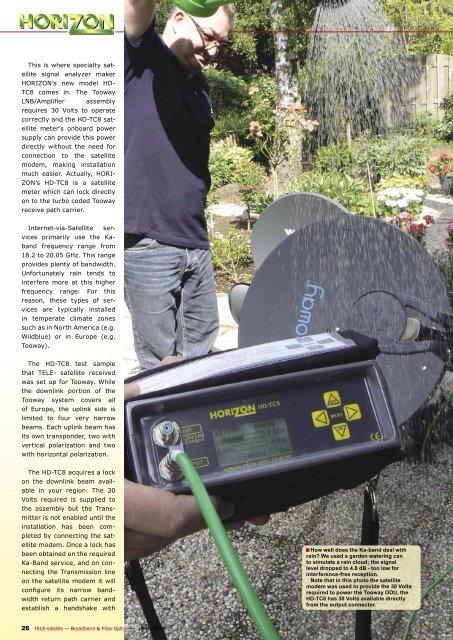_default _146_pages.indd - TELE-satellite International Magazine
_default _146_pages.indd - TELE-satellite International Magazine
_default _146_pages.indd - TELE-satellite International Magazine
Create successful ePaper yourself
Turn your PDF publications into a flip-book with our unique Google optimized e-Paper software.
This is where specialty <strong>satellite</strong><br />
signal analyzer maker<br />
HORIZON’s new model HD-<br />
TC8 comes in. The Tooway<br />
LNB/Amplifier assembly<br />
requires 30 Volts to operate<br />
correctly and the HD-TC8 <strong>satellite</strong><br />
meter’s onboard power<br />
supply can provide this power<br />
directly without the need for<br />
connection to the <strong>satellite</strong><br />
modem, making installation<br />
much easier. Actually, HORI-<br />
ZON’s HD-TC8 is a <strong>satellite</strong><br />
meter which can lock directly<br />
on to the turbo coded Tooway<br />
receive path carrier.<br />
Internet-via-Satellite services<br />
primarily use the Kaband<br />
frequency range from<br />
18.2 to 20.05 GHz. This range<br />
provides plenty of bandwidth.<br />
Unfortunately rain tends to<br />
interfere more at this higher<br />
frequency range. For this<br />
reason, these types of services<br />
are typically installed<br />
in temperate climate zones<br />
such as in North America (e.g.<br />
Wildblue) or in Europe (e.g.<br />
Tooway).<br />
The HD-TC8 test sample<br />
that <strong>TELE</strong>- <strong>satellite</strong> received<br />
was set up for Tooway. While<br />
the downlink portion of the<br />
Tooway system covers all<br />
of Europe, the uplink side is<br />
limited to four very narrow<br />
beams. Each uplink beam has<br />
its own transponder, two with<br />
vertical polarization and two<br />
with horizontal polarization.<br />
The HD-TC8 acquires a lock<br />
on the downlink beam available<br />
in your region. The 30<br />
Volts required is supplied to<br />
the assembly but the Transmitter<br />
is not enabled until the<br />
installation has been completed<br />
by connecting the <strong>satellite</strong><br />
modem. Once a lock has<br />
been obtained on the required<br />
Ka-Band service, and on connecting<br />
the Transmission line<br />
on the <strong>satellite</strong> modem it will<br />
configure its narrow bandwidth<br />
return path carrier and<br />
establish a handshake with<br />
26 <strong>TELE</strong>-<strong>satellite</strong> — Broadband & Fiber-Optic — 10-11/2009 — www.<strong>TELE</strong>-<strong>satellite</strong>.com<br />
■<br />
How well does the Ka-band deal with<br />
rain? We used a garden watering can<br />
to simulate a rain cloud; the signal<br />
level dropped to 4.8 dB - too low for<br />
interference-free reception.<br />
Note that in this photo the <strong>satellite</strong><br />
modem was used to provide the 30 Volts<br />
required to power the Tooway ODU, the<br />
HD-TC8 has 30 Volts available directly<br />
from the output connector.
















